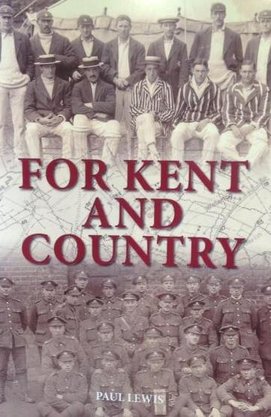For Kent and Country
Martin Chandler |Published: 2014
Pages: 371
Author: Paul Lewis
Publisher: Reveille Press
Rating: 4 stars

It was entirely appropriate that the centenary of the Great War last year should have prompted a frenetic outburst of publishing activity extending far beyond the field of military history. We reviewed two cricket books on the subject, the splendid Wisden on the Great War, and the sadly flawed The Final Over: The Cricketers of Summer 1914. There were however at least two others. I did spot one of those, Peter Jones’ A Torch in Flame: The Story of a County Cricket Club at War, probably more fairly called a booklet, which looked at the lives of five Hampshire cricketers who died in the conflict.
The book that managed to slip under my radar was this one, For Kent and Country. Like Jones’ effort the book is focused on a single county but there the similarity ends. This book is, in its rather more restricted field, every bit as thorough as Andrew Renshaw’s definitive collection of obituaries. There are 234 pages dedicated to pen portraits of varying length on every Kent cricketer who served in the War, of whom there were 97. Of those brave men 15 died and 24 more were wounded. Their stories are all gathered here.
I like to think that the reason I missed Paul Lewis’ splendid book is because it is not truly a cricket book at all – I would describe it as a military book with a cricketing theme. Thus the man who was by a distance the most famous of the cricketers featured, Frank Woolley, has considerably less space devoted to him than, for example, George Wood (capped three times in Tests as a wicketkeeper) and the entry relating to Wood is in turn rather shorter than that reserved for George Whitehead, a young man killed in 1918 who played just twice for the county.
The lives of the combatants therefore concentrate primarily on their role on the battlefield. The characters and personalities of the men often do not shine though, but that is inevitable given the matter of fact nature of the bulk of the source material used. The entries are nonetheless interesting and where they have been found the men’s own writings have been quoted, so for some there is flesh on the bones, none more so than Johnny Evans who, as AJ Evans, was given a single Test against Gregory and McDonald in 1921. His was an interesting life, and I also enjoyed reading a little more about Bill Fairservice, a long serving journeyman pro who was already a veteran when war broke out, and who came back for three seasons after the armistice. As a child I recall at one point owning an old instructional booklet that Fairservice wrote, or at least lent his name to, but before reading For Kent And Country his was a name I must confess I had forgotten, and he was a man I knew nothing about.
There is however rather more to the book than the stories of 97 men’s service. Inevitably there is some explanation of the build up to the declaration of war, and a very useful chapter entitled Who Did They Serve With. In many ways though the most interesting part of the book is the close on fifty pages that comprise chapter 3, which is entitled Theatres of War. I have always been fascinated by twentieth century history, and the Second World War, in many ways a more straightforward conflict I concede, I have always understood the course of. The Great War, on the other hand, I have always struggled with. I have found that however much I learnt about the individual battles, like Arras, those of the Somme and Ypres, and the more distant locations like Salonika and Gallipolli, I always struggled to put them in context and to make sense of how the War as a whole developed. I wouldn’t go as far as to say that Lewis’ prose has completely lightened my darkness, but there is a great deal more illumination than there once was.
I have no idea how For Kent And Country will be received by the military history market, but it is a book that deserves to succeed, and not just because Lewis has pledged all of his share of the profits to charity. The fact that it is not a cricket book per se will doubtless restrict its sales amongst the sport’s cognoscenti, but letting a perception of the book as a military work prevent a purchase would be a mistake. This is an excellent book the purchase of which I would commend to anyone.







Leave a comment